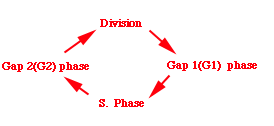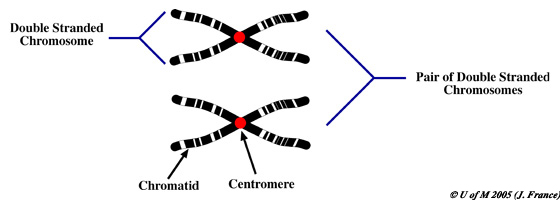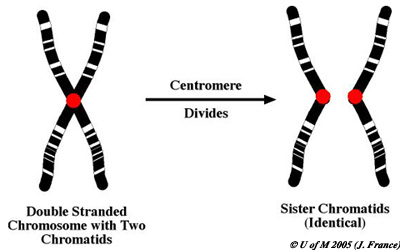
Eukaryotic cells reproduce in two different ways: mitosis and meiosis. It is absolutely essential that you understand and can clearly distinguish between the two. Without comprehension of these two methods of cell division an understanding of genetics and life cycles is impossible. Today we will be focusing on regular cell division (mitosis) as found in most eukaryotic cells. We will also be examining meiosis, a type of cell division involved in sexual reproduction.
Mitosis
(Canadina Campbell 2nd ed Concept 12.2)
As a consequence of mitosis, the nucleus divides resulting in two nuclei, each possessing identical hereditary information. The division of the nucleus is referred to as karyokinesis and the division of cytoplasm is termed cytokinesis. As a result of a combination of karyokinesis and cytokinesis, the parent cell after mitosis normally gives rise to two daughter cells, each with the same chromosome complement as the parent cell.
Through the process of mitosis, one fertilized egg cell can grow to a multicellular
individual containing millions of cells. Not only does mitosis produce new cells
but it also replaces dead cells, heals wounds and in some cases regenerates
lost or injured parts of the body. For example certain cell types such as red
blood cells, skin cells, and intestinal epithelial cells are continually being
lost and the basic means of replacement is through mitosis. Sometimes this type
of cell division gets out of control resulting in growth abnormalities. Uncontrolled
growth is characteristic of cancer. Therefore, a great deal of investigation
is carried out into the controlling mechanism responsible for the initiation
of cell division. Much has been learned but a great deal remains unknown.
You should now know that one cell can grow through numerous mitotic events to produce a multicellular organism. You should also recognize that in many organisms this same process leads to reproduction of new individuals. Uniparental reproduction involving mitosis as the basic division process is termed asexual.
-List several examples of asexual reproduction.
It is absolutely essential that you understand and can clearly distinguish mitosis and meiosis, the two methods of cellular reproduction in eukaryotes. Without comprehension of these two methods of cell division, an understanding of genetics and life cycles is impossible.
The period between successive divisions is known as interphase. A non-dividing or interphase cell is not a resting cell, as it is sometimes described, since it is during this period that the cell carries out all of the normal activities (growth, respiration, protein synthesis, etc.) of the cell with the exception of division. It is thus only resting from the actual process of division.
The interphase period may be subdivided into a number of recognizable stages, as follows:

In actively dividing cells, the actual division process may take 1 or 2 hours, the G1 phase approximately 8 hours, the S phase about 6 hours and the G2 phase about 4 to 5 hours. Thus, the total cell cycle (period from one division to the next) in actively dividing cells is quite short, lasting perhaps 20 hours.
Within dividing cells, the S phase is critical in that this is the period during which the DNA is replicated in preparation for the next division.
In other words, this is the period in the cell cycle in which the chromosomes become double stranded. Cells which complete the S phase almost invariably enter the G2 phase and proceed into cell division. Cells not destined to divide again (i.e.: certain epithelial cells, nerve cells, differentiated muscle cells, etc.) stop in the G1 phase and never enter the S phase. It is in the G1 phase that the cell is carrying out the normal metabolic processes for that particular cell type. Cells which reach the G2 phase are still metabolically active as well.
We usually divide the actual mitotic (division) process into a number of recognizable steps. Although each step is discussed separately, it is important to remember that the entire process is continuous. However, before you can understand mitosis you must understand the terminology used.

Each strand of the chromosome is known as a chromatid and the two chromatids making up the double stranded chromosome are attached at the centromere.
One of the first indications that a cell is about to divide occurs during prophase when the chromosomes become visible. They gradually condense into distinct double stranded chromosomes. Gradually, a spindle, composed of protein fibers forms and extends nearly the length of the cell, expanded in its middle region like two cones joined at their bases.
In animals cells structures called centrioles seem to control formation of the spindle (one set located at each pole). Plant cells usually do not contain centrioles. With the spindle formed, the chromosomes, each consisting of two chromatids, move along the spindle fibers toward the middle or equator of the spindle. Note that each chromosome is attached to a spindle fiber at the centromere.
- What happens to the chromosomes between the early and late stages of prophase?
Click to view:
With the arrival of all the centromeres at the equatorial plane (middle) of the cell metaphase begins.
Click to view:
This stage of mitosis ends when each chromosomal centromere divides so that each of the former chromatids becomes a single-stranded chromosome. Note that the sister chromatids are exact duplicates of each other. (see below)

Click to view:
- What are the differences between early anaphase and late anaphase?
Telophase begins with the arrival of the chromosomes at the poles of the spindles and ends with the complete reconstituting of the interphase condition in two daughter cells. In other words the reformation of a typical interphase nucleus.
Click to view:
- What is the difference between cytokinesis in plant and animal cells?
First published Sept 95: Modified June 2020
Copyright © Michael Shaw 2019 (Images and Text)
![]() Back
to Lab Index
Back
to Lab Index ![]() Forward
to Next Page
Forward
to Next Page ![]() University
of Manitoba Home
University
of Manitoba Home